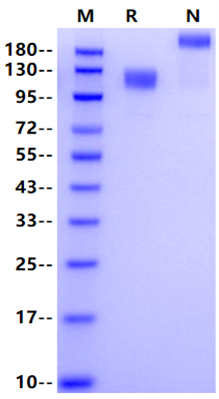Ala23-Ile507, with C-terminal Human IgG1 Fc AITEAREEAKPYPLFPGPLPGRLQTDHTSLLSLPHTSGYQPALMFSPTQPGRPYTGNVAIPRVTSAGSKLLPPLAFKHTVGHIILSEHKDVKFNCSISVPNIYQDTTISWWKDGKELLGAHHAITQFYPDDEVTAIIASFSITSVQRSDNGSYICKMKINNEEIVSDPIYIEVQGLPHFTKQPESMNVTRNTAFNLTCQAVGPPEPVNIFWVQNSSRVNEQPEKSPSVLTVPGLTEMAVFSCEAHNDKGLTVSKGVQINIKAIPSPPTEVSIHNSTAHSILISWVPGFDGYSPFRNCSVQVKEVDPLSNGSVMIFNTSASPHMYQIKQLQALANYSIGVSCMNEIGWSAVSPWILASTTEGAPSVAPLNVTVFLNESRDNVDIRWMKPLTKRQAGELVGYRISHVWQSAGISKELLEEVGQNNSRAQISVQVHNATCTVRIAAVTKGGVGPFSDPVKIFIPAHGWVDHAPSSTPAPGNADPVLIIIEGRMDPKSSDKTHTCPPCPAPELLGGPSVFLFPPKPKDTLMISRTPEVTCVVVDVSHEDPEVKFNWYVDGVEVHNAKTKPREEQYNSTYRVVSVLTVLHQDWLNGKEYKCKVSNKALPAPIEKTISKAKGQPREPQVYTLPPSRDELTKNQVSLTCLVKGFYPSDIAVEWESNGQPENNYKTTPPVLDSDGSFFLYSKLTVDKSRWQQGNVFSCSVMHEALHNHYTQKSLSLSPGK
1. Vissing H., Aagaard L., Tommerup N., Boel E. Localization of the human gene for advanced glycosylation end product-specific receptor (AGER) to chromosome 6p21.3. Genomics. 1994;24(3):606-608.
2. Yan S. D., Chen X., Fu J., et al. RAGE and amyloid-β peptide neurotoxicity in Alzheimer's disease. Nature. 1996;382(6593):685-691.
3. Deane R., du Yan S., Submamaryan R. K., et al. RAGE mediates amyloid-β peptide transport across the blood-brain barrier and accumulation in brain. Nature Medicine. 2003;9(7):907-913.
4. Krechler T., Jáchymová M., Mestek O., ?ák A., Zima T., Kalousová M. Soluble receptor for advanced glycation end-products (sRAGE) and polymorphisms of RA+U4GE and glyoxalase I genes in patients with pancreas cancer. Clinical Biochemistry. 2010;43(10-11):882-886.
Tyrosine-protein Kinase Mer, also known as c-Mer and MerTK, is a member of the receptor tyrosine kinase subfamily TAM (Tyro3, Axl, and Mer). Similar to Axl and Tyro3, the extracelluar domain of Mer contains two Ig-like motifs and two fibronectin type III motifs. Mer is not expressed in normal B- and T-cells but expressed in neoplastic B- and T-cell lines . It is also show higher expression in immunosuppressive M2‑like macrophages. Following activation by ligand, interacts with GRB2 or PLCG2 and induces phosphorylation of MAPK1, MAPK2, FAK/PTK2 or RAC1. MERTK signaling plays a role in various processes such as macrophage clearance of apoptotic cells, platelet aggregation, cytoskeleton reorganization and engulfment. Functions in the retinal pigment epithelium (RPE) as a regulator of rod outer segments fragments phagocytosis. Plays also an important role in inhibition of Toll-like receptors (TLRs)-mediated innate immune response by activating STAT1, which selectively induces production of suppressors of cytokine signaling SOCS1 and SOCS3.Mer is known to bind Gas6, Protein S, Tubby, Tubby-like protein 1 (Tulp1), and Galectin-3. Upon binding ligands via the Ig-like motif, Mer is dimerized to trans-autophosphorylate the kinase domain to induce downstream signaling. It has been shown that Mer signaling in macrophages induces M2 polarization, which promote tumor growth, metastasis and evasion of anti-tumor immunity in tumor microenviroment. Inhibition of Mer, especially on leukocytes and macrophages, is an effective anti-cancer therapy.

1μg (R: reducing condition, N: non-reducing condition).